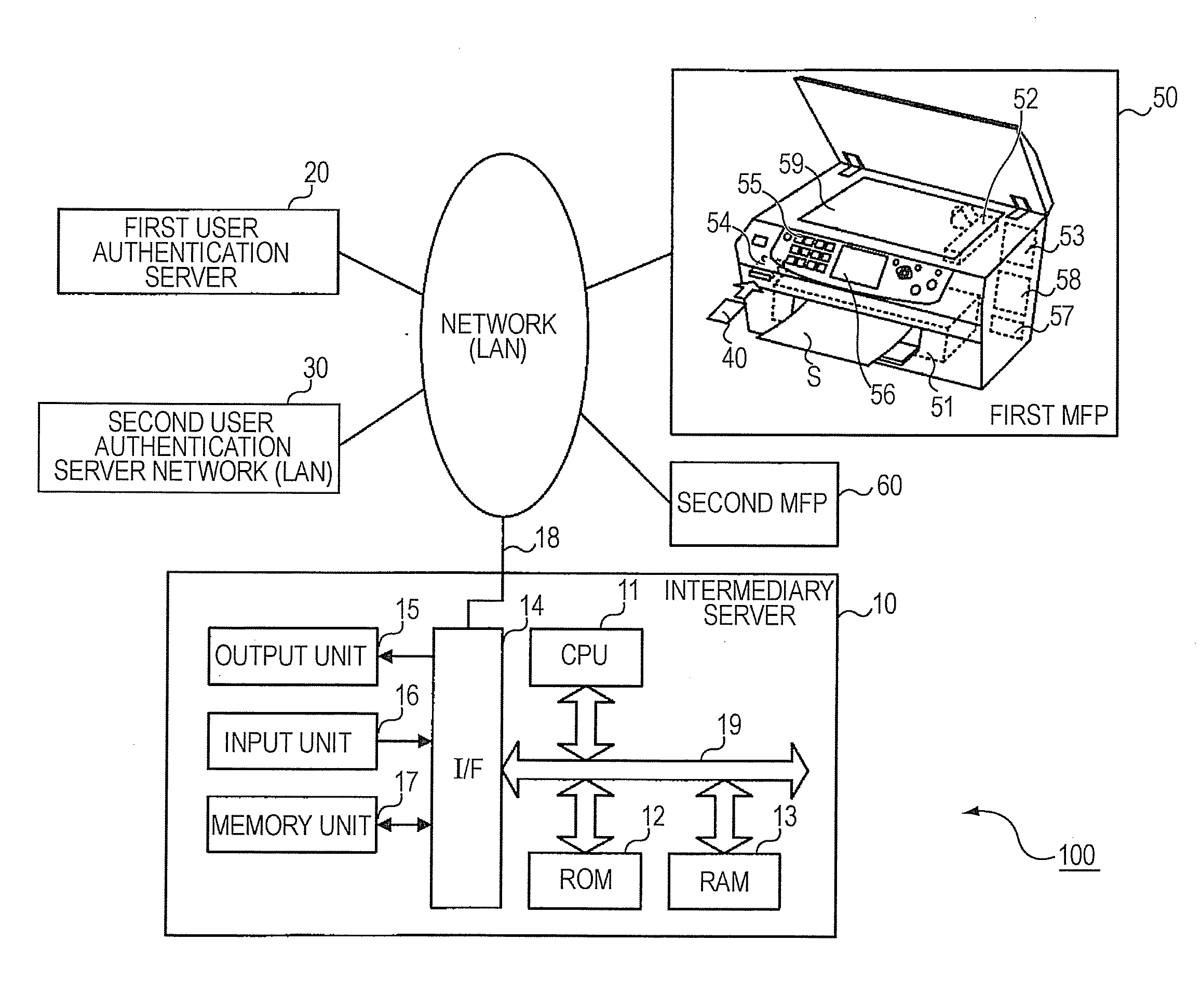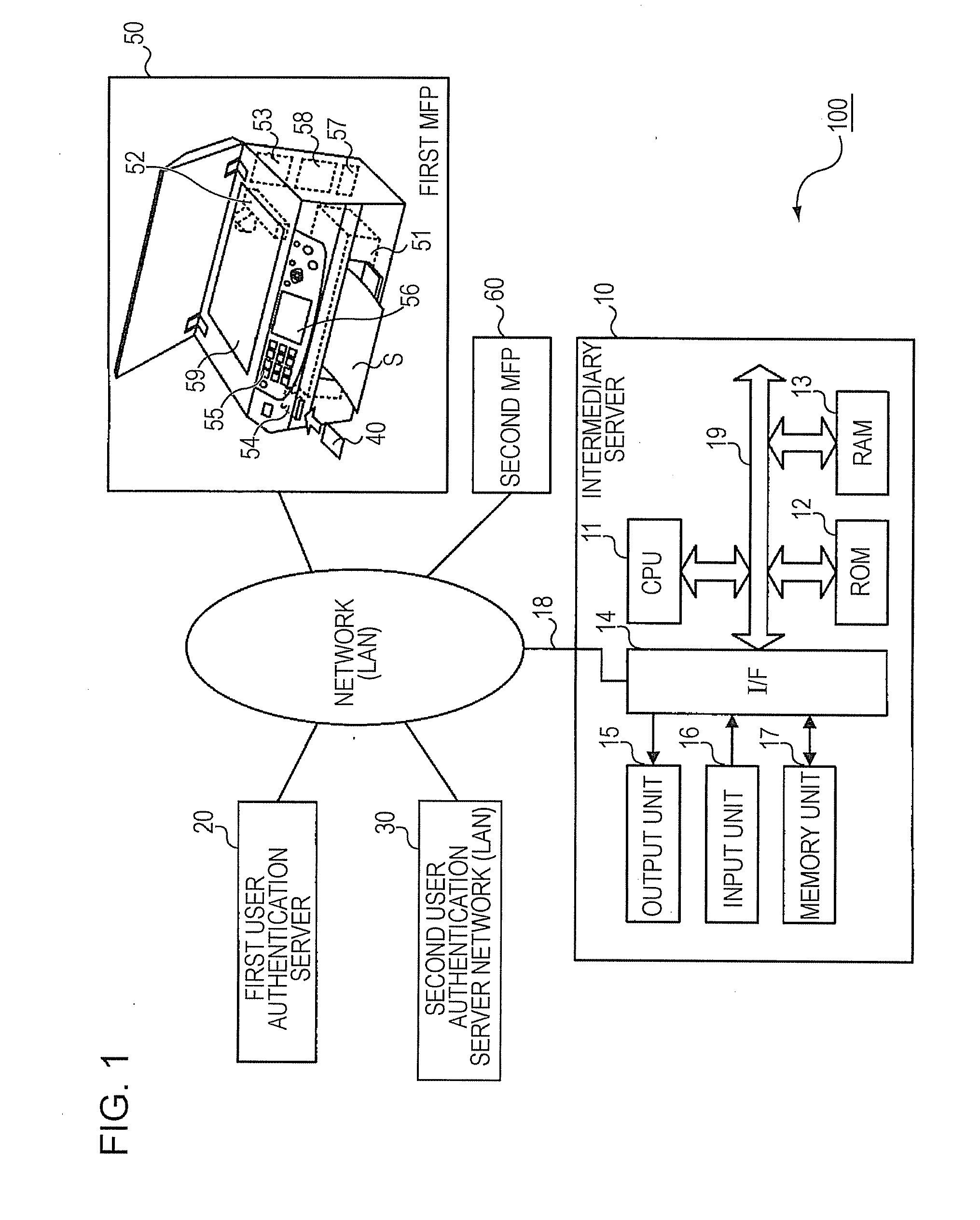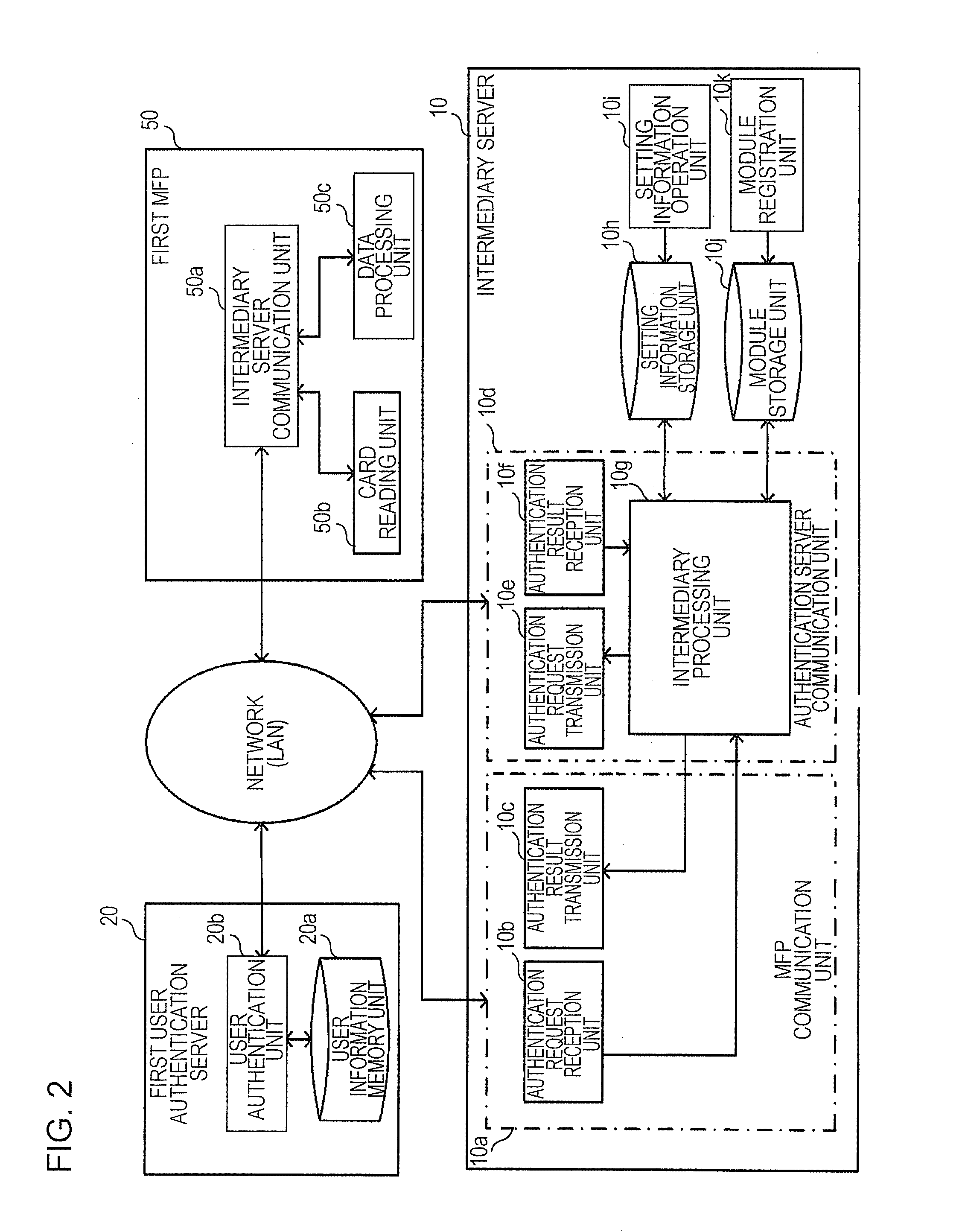[0012]It is preferable that the intermediary server according to the first aspect of the invention described above should further include: a correspondence storing section that pre-stores correspondences between determination information, which enables a determination of the authentication server, and the authentication server; and a correspondence setting section that enables a new correspondence to be registered into the correspondence storing section and further enables any correspondence that is registered in the correspondence storing section to be changed or deleted, wherein the above-mentioned at least one authentication server is not one but more than one authentication server; the request receiving section receives authentication request data from any of the plurality of devices, the authentication request data being created in the predetermined
common data format in such a manner that the authentication request data contains, without any limitation thereto, identification information that was inputted into the above-mentioned one of the plurality of devices and the determination information; and the authentication server communicating section determines the authentication server that corresponds to the received determination information on the basis of correspondences stored in the correspondence storing section, transmits the received identification information to the determined authentication server in a
data format that can be processed by the determined authentication server, and then receives, from the determined authentication server, the result of authentication performed by the determined authentication server on the basis of the transmitted identification information. With the preferred configuration of an intermediary server according to the first aspect of the invention described above, it is possible to produce the advantageous effects of the invention even when an
authentication system includes two or more authentication servers.
[0013]The plurality of authentication servers may be made up of two or more authentication servers of the same kind / type. Or, alternatively, the plurality of authentication servers may be made up of two or more authentication servers of different kinds / types. The identification information and the determination information may be separated from each other. Or, alternatively, one of the identification information and the determination information may double as, for example, contain, the other.
[0014]In the preferred configuration of an intermediary server that is connected not to only one authentication server but to more than one authentication server as described above, it is further preferable that the above-mentioned more than one authentication server should include but not limited to at least one
user authentication server that performs
user authentication and a device authentication server that performs device authentication; the request receiving section should receive authentication request data from any of the plurality of devices, the authentication request data being created in the predetermined
common data format in such a manner that the authentication request data contains, without any limitation thereto, identification information that was inputted into the above-mentioned one of the plurality of devices, identification information that is unique to the above-mentioned one of the plurality of devices, and the determination information; the authentication server communicating section should transmit the received device identification information to the device authentication server in a data format that can be processed by the device authentication server and then should receive, from the device authentication server, the result of device authentication performed by the device authentication server on the basis of the transmitted device identification information; and the authentication server communicating section should determine, if the received result of the device authentication is a success, the
user authentication server that corresponds to the received determination information on the basis of correspondences stored in the correspondence storing section, should transmit the received identification information to the determined user authentication server in a data format that can be processed by the determined user authentication server, and then should receive, from the determined user authentication server, the result of user authentication performed by the determined user authentication server on the basis of the transmitted identification information. With such a preferred configuration, it is possible to perform user authentication only for some devices that are listed as the target of user authentication.
[0015]In the preferred configuration of an intermediary server that is connected not to only one authentication server but to more than one authentication server, it is further preferable that the correspondence storing section should pre-store the correspondences in the form of script file(s). An example of the script file is a
macro file, though not necessarily limited thereto. With the preferred configuration of an intermediary server described above, when an
original data format that conforms to one which is accessible (can be processed) by the authentication server is changed for any reason into another data format or when there is an addition of another authentication server, it is not necessary to change the setting / configuration of each of the plurality of devices on an individual basis. That is, when such change or addition occurs, it is possible to make an
authentication system work by merely changing or deleting the script file that is stored in a memory / storage unit or adding another script file into the memory / storage unit. For this reason, the intermediary server having a preferred configuration described above releases users from the burden of setting changes when such change or addition occurs.
[0016]The invention provides, as a second aspect thereof, a method for controlling, by means of a
computer software, an intermediary server that intermediates between at least one authentication server that performs authentication and a plurality of devices that performs various kinds of
processing in accordance with the result of the authentication performed by the authentication server, the intermediary server controlling method including: (a) receiving authentication request data from any of the plurality of devices, the authentication request data being created in a predetermined common data format in such a manner that the authentication request data contains, without any limitation thereto, identification information that was inputted into the above-mentioned one of the plurality of devices; (b) transmitting the received identification information to the authentication server in a data format that can be processed by the authentication server and then receiving, from the authentication server, the result of authentication performed by the authentication server on the basis of the transmitted identification information; and (c) transmitting the received result of the authentication to the above-mentioned one of the plurality of devices that is the original sender of the authentication request data.
[0017]In an intermediary server controlling method according to the second aspect of the invention described above, an intermediary server receives authentication request data from any of the plurality of devices, where the authentication request data is created in a predetermined common data format in such a manner that the authentication request data contains, without any limitation thereto, identification information that was inputted into the above-mentioned one of the plurality of devices (or identification information that is unique to the above-mentioned one of the plurality of devices). A non-limiting example of the predetermined common data format is an
XML data format. The intermediary server transmits the received identification information to the authentication server in a data format that can be processed by the authentication server and then receives, from the authentication server, the result of authentication performed by the authentication server on the basis of the transmitted identification information. The intermediary server transmits the received result of the authentication to the above-mentioned one of the plurality of devices that is the original sender of the authentication request data. That is, in an intermediary server controlling method according to the second aspect of the invention described above, the intermediary server receives authentication request data that is created in a common data format from any of a plurality of devices. On the other hand, in an intermediary server controlling method according to the second aspect of the invention described above, the intermediary server transmits identification information to the authentication server in a data format that conforms to one that can be processed by the authentication server. Therefore, when an
original data format that conforms to one which is accessible (can be processed) by the authentication server is changed for any reason into another data format or when there is an addition of another authentication server, it is not necessary to change the setting / configuration of each of the plurality of devices on an individual basis. That is, when such change or addition occurs, it is possible to make an
authentication system work by merely changing the setting / configuration of the intermediary server according to the first aspect of the invention described above. For this reason, the intermediary server controlling method according to the second aspect of the invention described above releases users from the burden of setting changes when such change or addition occurs. It should be noted that further step(s) may be added to the above-described basic steps of an intermediary server controlling method according to the second aspect of the invention in order to realize operation / working-effects and / or functions that are offered by constituent elements of an intermediary server according to the first aspect of the invention described above.
 Login to View More
Login to View More  Login to View More
Login to View More 


